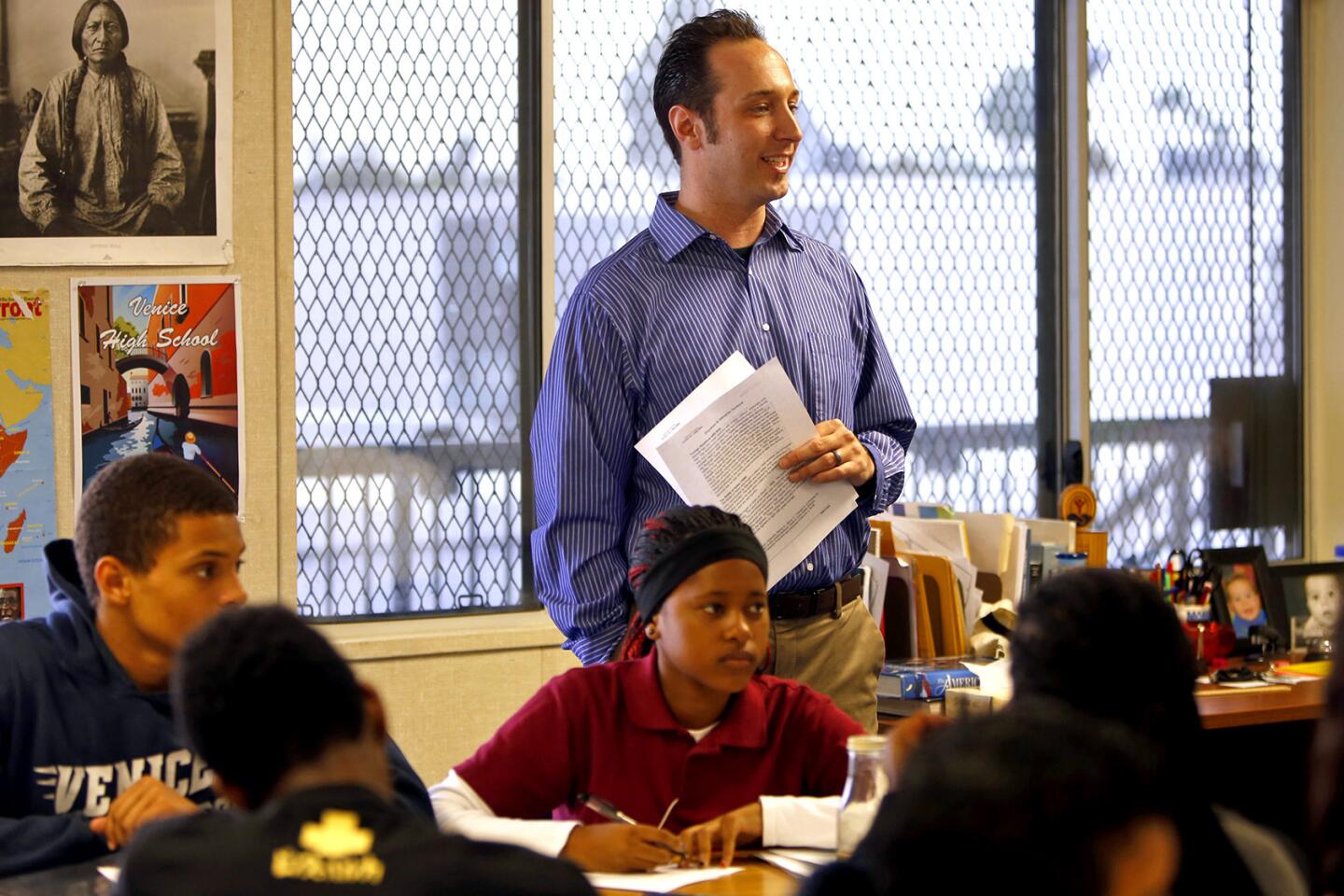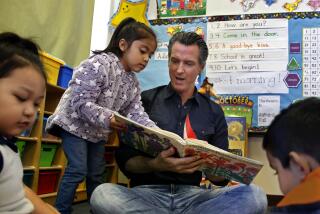L.A. Unified adopts free history curriculum from Stanford University
Venice High sophomore Vanessa Pepperdine had always hated history class: the dry lectures, the boring textbooks, the forgettable factoids about famous dead people.
“You just read out of the textbook, and it wasn’t interesting,” Vanessa said.
But during a recent period of World History, Vanessa and her classmates were engaged in excited discussion about the 1896 Battle of Adwa between Ethiopia and Italy. Their teacher, Daniel Buccieri, showed them an illustration of the event and peppered them with questions.
Who do you think won? How do the American and Ethiopian accounts differ and why? How was Ethiopia able to defeat Italy in this pushback of European imperialism?
With that, the students became sleuthing historians in search of truth rather than passive recipients of a droning lecture.
That’s the aim of a free, online Stanford University curriculum that is picking up steam nationally as educators grapple with widespread evidence of historical illiteracy among U.S. students.
Only about a third of Los Angeles Unified School District high schoolers were proficient on state standardized U.S. and world history tests last year; nationally, 12% were proficient in U.S. history in the 2010 National Assessment of Educational Progress exam.
L.A. Unified became the curriculum’s largest booster this year when it signed an 18-month, $140,000 contract with the Stanford History Education Group for training and collaborating on more lesson plans. So far, 385 teachers and administrators — including about 40% of the social science instructors in the nation’s second-largest school system — have attended Stanford-led workshops this year.
Nationally, the curriculum has been downloaded 1.7 million times by educators in all 50 states since the program was launched in 2009.
As the teaching of history comes under national scrutiny, with critics attacking the new Advanced Placement U.S. history guidelines as anti-American, the Stanford program takes no sides. With more than 100 ready-made lesson plans covering a range of U.S. and world events, the curriculum features a central historical question and provides primary documents for students to use in shaping their own answers, backed by evidence.
Was ancient Athens truly democratic? Were the “Dark Ages” really dark? Why did Chinese students support the Cultural Revolution? Did Abraham Lincoln actually believe in racial equality? What made the Vietnam War so contentious?
“This overturns the traditional textbook,” said Sam Wineburg, the Stanford education professor whose research more than two decades ago laid the groundwork for the approach. “Students explore questions with original documents and cultivate a sense of literacy and how to develop sound judgment.”
In a 2001 book, Wineburg argued that students must be trained to question history in order to understand it, just as professionals do; the curriculum is called “Reading Like a Historian.” The ability to question the credibility of information and its sources, he said, is critically relevant in today’s digital age — judging claims, for instance, that President Obama was born in Kenya.
The Stanford group has also developed free assessments, more than 65 so far, that gauge mastery of the targeted skills through short essay questions rather than traditional multiple-choice tests. In a test run five years ago, 236 students in five San Francisco high schools using the curriculum outperformed peers in factual knowledge and reading comprehension compared with those in traditional classes, Wineburg said.
For school systems such as L.A. Unified, the curriculum came at an opportune time — just as the district is shifting to new learning standards known as Common Core. The standards focus on cultivating such skills as reading complex texts and integrating and evaluating information from multiple sources.
“The Stanford curriculum aligns almost perfectly with Common Core,” said Kieley Jackson, a district coordinator of social science curriculum.
Not all teachers have embraced the lessons. Some say they take too long, typically four days, although Stanford trainers say they can be adapted for one or two. Others say they are short on content. And some instructors prefer their approach of lectures and textbooks. Only about a quarter of social science teachers at Hollywood High use the curriculum, said Neil Fitzpatrick, the department chair.
But Fitzpatrick and many of the 60 colleagues who attended a training this month praised the curriculum and shared ideas on how they modified it — actions that Stanford fully supports — with bingo games, film clips, Play-Doh, poetry, poster sets, Google images.
Buccieri, of Venice High, said he added the Italian perspective of the Battle of Adwa to further enrich the lesson. He said he began incorporating elements of Wineburg’s approach after reading his book more than a decade ago and found the Stanford curriculum on his own four years ago.
“History isn’t a set of answers I’m passing down to kids,” he said. “It’s more a set of questions and problems. To me, that’s more exciting.”
Many students seem to agree. Michael Corley, a history teacher at Polytechnic High in Sun Valley, said nearly 90% of about 100 students he polled preferred the Stanford curriculum over their textbook.
Students don’t feel they can argue with the textbook, he said. But using the Stanford lesson on Prohibition to debate why the 18th Amendment banning alcohol was adopted and evaluating perspectives about it from a medical doctor, anti-saloon activist and children’s rights advocate? Now that excites them, he said.
He added that the Stanford curriculum seems to especially engage boys, perhaps by appealing to their competitive “gamer mentality,” and said his students who typically earn Cs and Ds also do well because the lessons spark their interest. “You can see what they’re truly capable of,” he said.
At Venice High, Buccieri’s 10th grade students said their teacher’s approach has completely changed their attitude toward history.
Rosio Salas said she had 10 substitutes in one year who did nothing but assign textbook readings and worksheets. She didn’t remember anything she learned. “You just did it because you had to do it.”
Now, students say history is exciting. They understand it. They even remember it — as classmate James Gregorio proved by explaining that a Serbian terrorist’s assassination of Archduke Franz Ferdinand of Austria ignited World War I.
“You’re not just sitting there having to listen to him,” sophomore Drew Anderson said. “You get to figure things out for yourself.”
Twitter: @TeresaWatanabe
More to Read
Start your day right
Sign up for Essential California for news, features and recommendations from the L.A. Times and beyond in your inbox six days a week.
You may occasionally receive promotional content from the Los Angeles Times.













